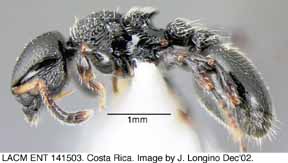

Formicidae, Hymenoptera, Insecta, Arthropoda, Animalia
|
|
|
Image catalogue, worker (click here).
Image catalogue, worker, sem (click here).
Range
Colombia, Costa Rica.
Description of worker:
Worker measurements (n=1, Costa Rica): HW 0.929, HL 0.920, SL 0.577, EL 0.236, MeL 1.073, MeW 0.652, PrW 0.545, PrL 0.283, PrS 0.123, PrT 0.405, MTL 0.577, MFL 0.634, MFW 0.236, PtL 0.338, PtW 0.311, PpW 0.443, PtH 0.307, AL 1.094, AW 0.982.
Head roughly circular in outline; frontal carina ending on and fused with dorsal torulus, thickened where it approaches torulus; face to vertex margin with widely dispersed small foveae, densest on anterior third of face, absent from posteromedial face; interspaces subgranular with fine areolate etchings; clypeus at level of antennal insertions evenly curved ventrad, with small pair of broadly obtuse teeth projecting outward from anterior margin; clypeus with fine areolate microsculpture and faint longitudinal rugulae; genae with areolate microsculpture and sparse small foveae; genal bridge longitudinally striate; mandible mat, with feeble longitudinal striae; in anterior view, eyes asymmetrically convex, skewed ventrad; scape somewhat flattened distally, becoming more terete basally, basal flange moderately developed; margin of vertex smoothly rounded, not carinate or crenate; vertex smooth and shiny.
Lateral lobes of mesonotum indistinct, at most broadly obtuse angles; propodeal suture a broad, shallow trough, visible as a depression in profile; dorsal face of propodeum with anterolateral lobes distinct; promesonotum coarsely and closely foveate; propodeal suture with regular parallel striae which continue onto dorsal face of propodeum, dorsal face of propodeum with variable combination of foveae and longitudinal striae; posterior face of propodeum perpendicular to dorsal face, slightly concave, largely smooth and shining; pronotal dorsum rounds onto lateral face, lateral face with row of foveae dorsally, coarse parallel striae ventrally; anepisternum, katepisternum, and lateral propodeum vary from largely smooth and shining to longitudinally striate; coxae smooth; hind femur strongly swollen medially, spindle-shaped; posterior surface of forefemur smooth; outer surface of metatibia feebly rugose.
Ventral margin of petiole flat, ending anteriorly in a small, indistinct right-angled tooth; anterodorsal face of petiole differentiated from longer posterodorsal face, meeting at broadly obtuse angle; anterior face smooth and shining; posterior face coarsely reticulate rugose; ventral margin of postpetiole short, with a prominent, acute anterior tooth; postpetiolar dorsum shallowly convex, without distinct anterior and posterior faces; surface coarsely reticulate rugose; anterior third to half of first gastral tergite with feeble irregular longitudinal rugae with interspersed puncta, this sculpture fading to nearly smooth and shiny posteriorly (Weber series from Medellin with this sculpture nearly effaced, largely smooth and shiny); anterolateral portion of first gastral sternite with a few oblique rugulae, remainder smooth with uniform cover of sparse, small puncta; second gastral tergite smooth or with areolate microsculpture.
Disc of face with 1-2 erect setae; promesonotum with moderately abundant short flexuous setae; setae longer, denser, subdecumbent on dorsal face of propodeum, petiole, and postpetiole; first gastral tergite with cluster of longer, flexuous setae near postpetiolar insertion, grading to a variably developed dense subdecumbent pubescence posteriorly; color shining black, scapes orange, flagellum and legs varying from brown to orange.
Description of queen:
Queen measurements (n=1, Colombia): HW 0.931, HL 0.912, SL 0.600, EL 0.330, MeL 1.500, MeW 0.827, MTL 0.619, MFL 0.676, MFW 0.231, PtL 0.406, PtW 0.321, PpW 0.457, PtH 0.308, AL 1.405, AW 1.045.
Similar to worker in most respects; foveae more extensive on face relative to worker, but still weakening medially, reduced to small scattered puncta around ocellar triangle; pronotum, mesoscutum, axillae, and scutellum foveate; interspaces subequal to or greater than fovea diameter, with microareolate sculpture; dorsal face of propodeum irregularly rugose-foveate.
Comments:
Procryptocerus coriarius and P. schmitti are extremely similar, the only known differences being the more deeply impressed propodeal suture and the shallower, more sparse foveae on the face of P. coriarius (Kempf, 1951). Procryptocerus coriarius has the face largely smooth and shining, with faint foveae confined to the anterior one-third. Procryptocerus schmitti has the face uniformly foveate. The type of P. coriarius, from Bogotá, is somewhat intermediate. Although most similar to the other material identified as P. coriarius here, the foveae on the face are stronger and extend further onto the disc.
Procryptocerus coriarius and P. schmitti have a parapatric or allopatric distribution. Procryptocerus coriarius occurs from Costa Rica to Colombia. Procryptocerus schmitti occurs in Venezuela and the northeastern states of Brazil, south to Bahia (see under P. schmitti).
Natural History
This is a very rarely encountered species. One Colombian collection was found nesting in withered branches of coffee shrubs (Kempf, 1951). The Costa Rican collection from Guayabo is a dealate queen. The collection from Carrillo was from rainforest, a single worker from low vegetation. Weber's Medellin collection is a nest series with a queen and a male.
Types and Synonymy
Cataulacus coriarius Mayr 1870:414. Holotype worker: Colombia, Bogota, "S. Fe" (Lindig) [NMW].
Procryptocerus coriarius: Emery, 1887:470; Kempf, 1951:36-39, fig. 4, 25, 54, 69, 93 (description of type worker, nontype queen).
Page author:
John T. Longino, The Evergreen State College, Olympia WA 98505 USA. longinoj@evergreen.edu
Date of this version: 6 December 2002.